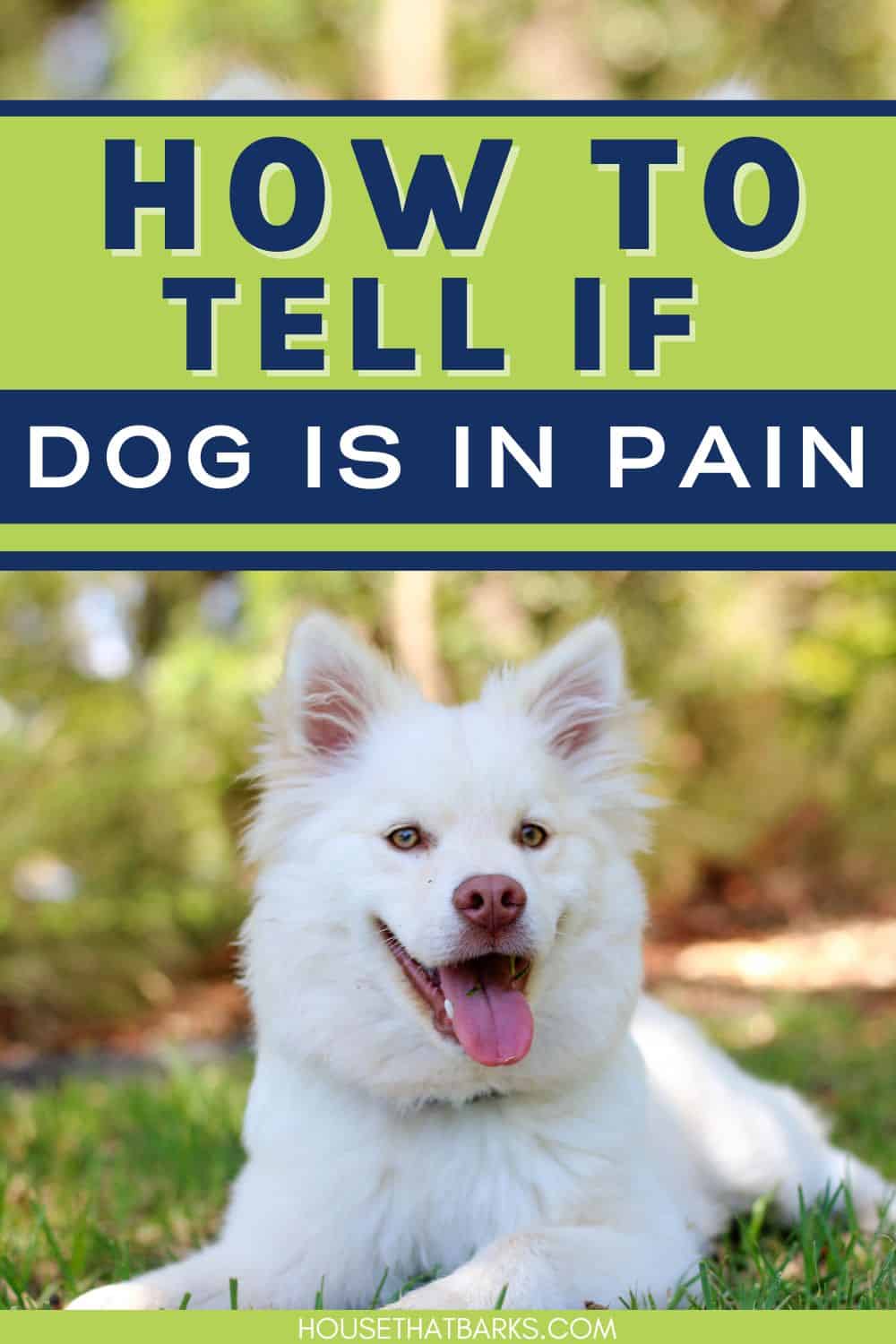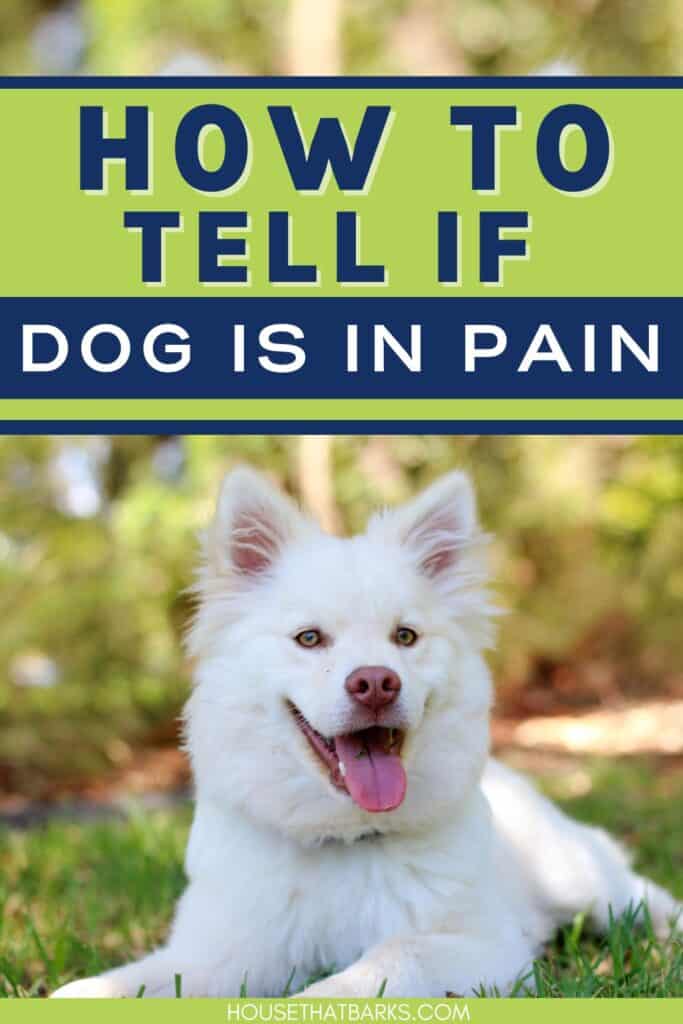Pain in dogs can be difficult to spot because dogs are incredibly adept at hiding it.
No pet owner wants their beloved furry friend to be in pain, but unfortunately this is a reality for many dogs.
Since dogs cannot tell us when they are hurting, it's up to us as dog owners to watch and recognize any subtle changes in your dog's behavior that can indicate if they are in chronic pain.
One of the most common symptoms that a dog is in pain is limping or difficulty moving around, changes in eating habits and activity level, panting excessively, hiding away from family members or other animals, whining when touched or move around and becoming irritable with excessive licking.

How Do I know If My Dog Is In Pain?
Dog's are amazingly resilient and loyal creatures, yet they can't tell us when they are in pain. Fortunately, dog's show some common clues when they're uncomfortable or in distress.
Some of the more obvious indicators of pain:
- Limping or favoring a particular limb.
- Licking or chewing at an area excessively.
- Stopping eating or drinking.
- Increased lethargy and painting or trembling.
- Agitation when there is none.
- Tight or twitching muscles.
- Arched back
- Holding their head below their shoulders.
- Refusing to jump on furniture.
- Unable to keep up on long walks.
Dog owners should pay extra close attention to these changes if the behavior is not typical for your dog, as it could signal underlying issues.
Additionally, any kind of limping or lameness should be noted by a veterinarian.
With the right care and early detection methods, dog owners can successfully manage and reduce the pain their furry friends may experience.
Behavioral Changes in Dogs
- Not wanting to be touched.
- Excessive vocalization.
- Restlessness.
- Aggression.
It is not unusual for a dog in pain to exhibit behavioral changes. Just likes us, they will become more cranky and less sociable than usual when they are in pain.
While some dogs may retreat into themselves, others can become more vocal or more aggressive to express their pain. '
Not wanting to be touched or cuddled is often a sign, which can potentially indicate there is something wrong and needs to be addressed.
Also excessive vocalization can mean their body is experiencing discomfort and your dog can't help but express it through barking or whining louder than usual.
Lastly, restlessness can also point out that there's an issue at hand since dogs usually love being physically active and not engaging in this activity can mean that there's something wrong and it may be time to visit the vet.
Disclosure: Some of the links in this article are affiliate links (Amazon Associate or other programs we take part in). As an Amazon Associate, I earn a small commission from qualifying purchases.
Mobility Issues
- Limping
- Reluctance to jump on furniture or use the stairs
- Difficulties laying down or getting up
Changes in mobility issues can be one of the first signs of pain in your dog. If you notice that your dog is limping, walking slower or refusing to walk, and/or has difficulty lying down and getting up they may be in pain.
Additional signs of pain include reluctance to jump or use the stairs as these activities may put too much pressure on the affected areas that can cause discomfort.
It's important to take notice of all the changes in your dog's behavior as catching issues early is key for early treatment or pain management.

Antisocial or Aggressive Behavior in Dogs
When it comes to dogs, antisocial or aggressive behavior can be a sign of serious underlying problems and/or pain.
While aggression is the most common form of pain, other signs may include your dog avoiding contact or not greeting you at the door with it's normal enthusiasm.
Discomfort from injury, illness, or even a parasite can be other possibilities for antisocial or aggressive behavior in your dogs.
Whatever the cause may be, if you notice any drastic changes in your dogs behavior, it's best to consult your veterinarian before things get too painful or out of hand.
When Your Dog Is More Vocal
It's natural for dogs to be vocal, so when they become more vocal than usual it could be an indicator of pain.
Since dog's can't express how they truly feel with words, excessive yelping, growling, snarling and even howling can be your dog's way of signaling that something isn't right.
Unfortunately, sometimes the cause of their pain can be difficult to pinpoint without a complete checkup. If your worried about the pain your dog may be in then it's best to take them in and have them checked out.
Many clinics offer specialized services and scans which can pinpoint what could be causing the pain that your dog is feeling. It's essential to address your dog's pain as soon as possible, this will help relieve any unnecessary suffering.
Excessive Grooming
Excessive grooming in dogs can be an attempt to soothe themselves, especially when there is an irritation or pain that isn't noticeable.
It's fairly common behavior with dogs to lick and scratch at their fur to try to calm themselves.
When your dog is licking their paws persistently, it could be a sign of physical injury such as cuts or scrapes. however the pain can also be internal or inflammation.
Over grooming can lead to irritated skin which sometimes results in infection if not treated properly.
If you notice any balding patches on the skin then this is definitely something worthy of taking your dog to the vet for examination as soon as possible.
Heavy Panting or Altered Breathing
Panting is a normal way for dogs to regulate their body temperature, however heavy panting or altered breathing is usually a sign of something being wrong.
Heavy or excessive panting can be caused by extreme weather, high temperatures, or even stress.
Panting can also indicate physical illness when there is no reasonable explanation for your dog's behavior.
Dogs will also show signs of shallow or labored breathing which should be monitored. Shallow or labored breathing does not necessarily mean there is something wrong with the lungs however it could mean that the dog has some kind of pain that restrict their ability to take deep breaths.
Signs such as weakened barking, lips drawing back to expose teeth, hunching over while breathing should all be looked at as soon as possible and treatment should begin immediately if anything looks suspicious.
Panting and altered breathing are certainly a warning sign that something isn't right and any changes in your pet's behavior should always receive immediate attention and care from a vet.
Loss of Appetite
It is an unfortunate truth that at some point in our beloved dog's lives, they may experience a loss of appetite.
Whether due to age-related issues, illness or pain, many dog owners are face with the challenge of helping their dog stay fed and nourished despite this lack of hunger.
Weight Loss in Dogs
Weight loss in dogs can often be tricky to identify and can be a sign of underlying medical conditions.
When you notice that your pup is losing weight rapidly, it's important to take action quickly and seek out advice from your veterinarian.
Weight loss can have numerous causes, such as not eating enough or changes within their metabolism due to certain conditions like digestive issues, diabetes or even cancer.
Your pup can lose interest in food if they are in pain.
Changes in Your Dogs Eyes
When a dog is in pain related to their eyes, the most obvious sysmpton to spot is an increase in squinting.
Dogs are unable to completely close their eyelids, so instead they use facial muscles to effectively scrunch them shut. This may be accompanied by closing one eye more than the other if the pain affects one side of the face more.
In more severe cases this can sometimes restrict vision and make normal activities difficult for your dog.
Another tell-tale sign of eye discomfort is if the pupils appear smaller than usual.
Typically, when dogs are experiencing pain elsewhere on their body, their pupils will dilate in response which can help signal something might be amiss. However, this varies depending on the type of injury or medical condition present and can be beneficial information for a vet to have when diagnosing the issue at hand.
Increased Thirst
Dog's facing pain often exhibit a decrease in appetite and thirst, something that their owners may notice if their dog is eating significantly less than usual.
In some cases, this decreased level of food or water intake may be due to pain or discomfort in different mouth-related areas.
For instance, if the dog has recently suffered an injury or has undergone dental surgery, they might experience difficulty while they eat or drink. When this happens, your dog may drop food and/or water from its mouth since it is not able to swallow properly.
This should be monitored closely s dogs that don't get enough food or water can become very weak and even suffer further medical issues such as urinary tract infections.
If you notice that your dog is having trouble with drinking or eating due to what appears to be mouth-related pain, talk to your veterinarian about treatment options and follow-up care.
What Can I Do For My Dog In Pain
Managing pain in dogs can be a challenge and it is important to find relief for your pet as soon as possible.
There are a number of human medications for pain relief solutions available for dogs including over-the-counter medicines, joint supplements, natural oils and more.
For mild occasional or temporary pains there are some natural joint supplements containing omega-3 fatty acids and glucosamine may help ease joint and bone stiffness.
Natural oils such as coconut oil or cod liver oil may help reduce inflammation caused by different arthritis or skin conditions. However, if the symptoms persist over time or become worse you should consult with a veterinarian about other options.
Depending on the severity of the pain it might be best to opt for professional treatment rather than relying solely on over-the-counter medications and supplements.
Discussing Pain Treatments with Your Veterinarian
When it comes to searching for the best treatment option for your hurting dog, you should always start by talking to your veterinarian.
Not only will they be able to provide the necessary medical advice and care, but they are also a great source of information when it comes to understanding your dog's needs and symptoms.
When discussing treatment options with your vet, it is important to ask questions regarding how the treatment will address your dog's pain relief as well as any supplements or adjustments that could help in managing pain.
Additionally, if surgery is a potential option, knowing what can be done at home to help with the recovery and associated pain management is important information to have.
Understanding how a particular supplement will help or what changes can be made in order to create a safe environment can make all the difference in caring for an injured or ill dog.
Ultimately, talking openly with your vet and having detailed conversations about all available treatments will enable you to find the best solution for your fur baby.
Pin It And Save It For Later







Leave a Reply